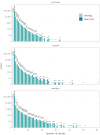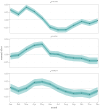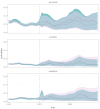Spatio-temporal modeling of co-dynamics of smallpox, measles, and pertussis in pre-healthcare Finland
- PMID: 39346083
- PMCID: PMC11439382
- DOI: 10.7717/peerj.18155
Spatio-temporal modeling of co-dynamics of smallpox, measles, and pertussis in pre-healthcare Finland
Abstract
Infections are known to interact as previous infections may have an effect on risk of succumbing to a new infection. The co-dynamics can be mediated by immunosuppression or modulation, shared environmental or climatic drivers, or competition for susceptible hosts. Research and statistical methods in epidemiology often concentrate on large pooled datasets, or high quality data from cities, leaving rural areas underrepresented in literature. Data considering rural populations are typically sparse and scarce, especially in the case of historical data sources, which may introduce considerable methodological challenges. In order to overcome many obstacles due to such data, we present a general Bayesian spatio-temporal model for disease co-dynamics. Applying the proposed model on historical (1820-1850) Finnish parish register data, we study the spread of infectious diseases in pre-healthcare Finland. We observe that measles, pertussis, and smallpox exhibit positively correlated dynamics, which could be attributed to immunosuppressive effects or, for example, the general weakening of the population due to recurring infections or poor nutritional conditions.
Keywords: Bayesian analysis; Infection co-dynamics; Measles; Pertussis; Smallpox; Spatio-temporal.
©2024 Pasanen et al.
Conflict of interest statement
The authors declare there are no competing interests.
Figures







Similar articles
-
Quantifying the consequences of measles-induced immune modulation for whooping cough epidemiology.Philos Trans R Soc Lond B Biol Sci. 2019 Jun 24;374(1775):20180270. doi: 10.1098/rstb.2018.0270. Philos Trans R Soc Lond B Biol Sci. 2019. PMID: 31056052 Free PMC article.
-
Epidemic disease in Glasgow during the 19th century.Scott Med J. 1996 Feb;41(1):24-7. doi: 10.1177/003693309604100110. Scott Med J. 1996. PMID: 8658120
-
Smallpox and measles: historical aspects and clinical differentiation.Infect Dis Clin North Am. 2004 Mar;18(1):79-100. doi: 10.1016/S0891-5520(03)00091-6. Infect Dis Clin North Am. 2004. PMID: 15081506
-
Association Between Vaccine Refusal and Vaccine-Preventable Diseases in the United States: A Review of Measles and Pertussis.JAMA. 2016 Mar 15;315(11):1149-58. doi: 10.1001/jama.2016.1353. JAMA. 2016. PMID: 26978210 Free PMC article. Review.
-
History of Smallpox and Its Spread in Human Populations.Microbiol Spectr. 2016 Aug;4(4). doi: 10.1128/microbiolspec.PoH-0004-2014. Microbiol Spectr. 2016. PMID: 27726788 Review.
References
-
- Bai J, Wang P. Identification and Bayesian estimation of dynamic factor models. Journal of Business & Economic Statistics. 2015;33(2):221–240. doi: 10.1080/07350015.2014.941467. - DOI
-
- Banner KM, Irvine KM, Rodhouse TJ. The use of Bayesian priors in ecology: the good, the bad and the not great. Methods in Ecology and Evolution. 2020;11(8):882–889. doi: 10.1111/2041-210X.13407. - DOI
-
- Betancourt M. A conceptual introduction to hamiltonian Monte Carlo. 20181701.02434
Publication types
MeSH terms
LinkOut - more resources
Full Text Sources
Medical

